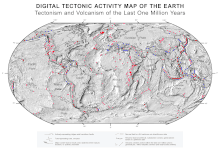Lithosphere

Layers according to chemical composition:
1 earth crust, 2 earth mantle, 3 earth core
( 3a outer earth core, 3b inner earth core)
Layers according to mechanical properties:
4 lithosphere , 5 asthenosphere,
6 outer earth core, 7 inner earth core
The lithosphere [ litoˈsfɛːrə ] ( stone shell , from Greek λίθος líthos 'stone' and σφαίρα sphära 'sphere') is the outermost layer in the rheological model of the structure of the earth's body. It includes the earth's crust and the outermost part of the earth's mantle , the lithospheric mantle . Overall, the lithosphere can be described as rigid . It is composed of individual plates known as lithospheric plates , tectonic plates or continental plates .
The asthenosphere follows directly below the lithosphere . The rock in this layer is solid, but behaves plastic (ductile) in geological time periods .
Structure and structure
The lithosphere consists of the upper and lower crust of the earth and the relatively rigid part of the upper mantle, the lithospheric mantle . The boundaries between these layers are seismologically verifiable and are called discontinuities.
The Mohorovičić discontinuity (short: Moho) forms the boundary between the crust and the underlying lithospheric mantle, on which an abrupt increase in the wave speed is evident due to the higher density of the mantle rock compared to the crustal rocks. At the lower-lying transition from the lithosphere to the asthenosphere, on the other hand, the wave speed suddenly decreases ( low velocity zone ), this is the Gutenberg discontinuity . The Conrad discontinuity forms the boundary between the upper and lower crust in the continental area .
The thickness of the entire lithosphere varies from a few kilometers on the mid-ocean ridge to 100 km or 200 km on the continents and averages around 100 km. The Moho is located in the continental lithosphere at depths of 30–50 km. With heavily thickened crust, e.g. B. under a young mountain range of folds , it is even at depths of up to 80 km. In the oceanic lithosphere, the Moho is only 5–7 km deep. Below the spreading zone of a mid-ocean ridge , the Moho directly indicates the transition to the asthenosphere, as the lithospheric mantle is missing there.
The lithosphere is divided into seven large lithospheric plates , which consist in different parts of continental and oceanic lithosphere. These are the North American Plate , the Eurasian Plate , the South American Plate , the African Plate , the Indo-Australian Plate , the Antarctic Plate, and the Pacific Plate . There are also other, small plates, such as B. the Nazca plate or the Philippine plate . The aforementioned large panels can also be further subdivided into various smaller panels. All these plates lie on top of the asthenosphere and are in constant motion, albeit hardly perceptible in human time scales.
dynamics
The rigid plates “float” on the comparatively ductile (yielding) asthenosphere . They are in constant motion with maximum speeds of more than 10 centimeters per year. Thermal convection currents in the earth's mantle are assumed to be one cause of this continental drift .
The dynamics of the lithospheric plates are commonly referred to as plate tectonics. With regard to the plate movements, there are three different modes:
-
converging plates (drifting towards each other)
- with oceanic lithosphere sliding down under another lithospheric plate ( subduction ), creating deep-sea channels and volcanically active mountain ranges ( e.g. Japanese islands and Japan trenches , Andes and Peru or Atacama trenches ).
- or with the formation of fold mountains through the collision of two continental blocks (e.g. Himalayas , Alps ). Here, the crust of one of the two plates involved is often separated from the lithospheric mantle (delamination).
- Diverging (drifting apart) plates: The plate boundary is expressed by a mid-ocean ridge (MOR) along the central axis of which new oceanic crust is constantly being formed by rising magma ( ocean floor spreading ). Large amounts of hot mineral solutions flow out of smaller crevices on the ocean floor of the MOR, creating black or white “smoking” tower-like structures in these areas (see Lost City ).
- Relative movements across the plate boundary (plates drifting "past each other")
As a result of plate tectonics, earthquakes and often volcanism are always found at all plate boundaries . In addition, the continental and oceanic crusts differ in age. While oceanic crusts typically only live to be 160 to 190 million years old due to subduction, there is continental crusts that are 4 billion years old.
See also
Individual evidence
- ^ Wolfgang Frisch, Martin Meschede, Ronald C. Blakey: Plate Tectonics - Continental Drift and Mountain Building. Springer, 2011, ISBN 978-3-540-76504-2 , p. 4 ff.


